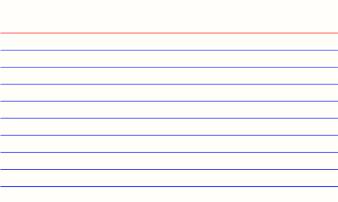Speaker's Notes
A common misconception about public speaking is that it must be done from memory. While a professor’s individual requirements may vary, the Speech Lab always encourages the use of speaker’s notes when possible. Speaker’s notes are for your eyes only and serve one purpose: to help you give the best presentation you can. Let’s take a closer look at a few ideas you will want to consider as you make your notes work for you.
Content
Believe it or not, poorly prepared speaker’s notes can hurt a presentation more than they help it. Think about it. What if the print is too small for you to easily see during the speech? You might decide hold the notes close to your face and squint. That delivery style is not going to help your credibility. Conversely, what if the print is too large? You do not want to be that speaker that brings a 5-inch binder up with them and flips to a new page after every—single—sentence. Also, on one hand, what if you try to write the majority of your presentation into your notes word-for-word? You are likely to find yourself reading directly from your notes and not making adequate eye contact with you audience. On the other hand, what if you only use single words and abbreviations but do not practice enough to remember what those words and abbreviations mean? You will become confused and nervous as you struggle to get through the speech.
The takeaway here is that you should find the Goldilocks amount of content for your notes. Not too much, not too little. Not too big, not too small. Including legible section headings and bulleted phrases (rather than full sentences OR single words) is the best way to ensure a conversational tone, frequent eye contact, and engaging delivery.
Pro Tip: Be sure to practice presentations as much as possible. If you have ample practice time, start with notes that have too much content. Practice and see what areas you are comfortable with and did not need the notes for. Delete or reduce those sections of the notes as you practice more and more until you have a manageable amount of content remaining.
Format
Now that you know what content might be on your notes, we need to find an effective format to use. The format you choose for your speaker’s notes is up to you most of the time. At the Speech Lab, we recommend using a full sheet of paper. However, there are other options.
Paper
Try using a single, full sheet of paper with your notes typed on it. Try these steps for your next speaking notes:
- Open up a new file using MS Word or Google Docs
- Change the orientation of the paper to landscape
- Create two columns
- Type your notes using a font/size that you can easily see
- Use up to two pages on your screen
- If needed, print the notes double sided to fit both pages on a single sheet of paper
- Fold the paper in half as seen in the image to the right
NOTE: If using both sides of the paper, fold the paper until a clear crease forms that is easy and quiet to open and close
Now you should be able to use your notes in one hand and simply flip the paper over to see the second page of notes
NOTE: If using both sides of the paper, you will need to open and reverse the paper at some point during the presentation

Notecards
A vast number of speakers use notecards while giving a presentation. However, we caution against using them for speaking notes unless they are specifically required. There are two big dangers when using note cards.
First, note cards are easy to drop and, if there is a sizable stack of them, get out of order when you are picking them up. Also, your audience will see you get down in the floor and collect your cards. It seems cruel, but you aren’t likely to have your message resonate with that audience.
Second, for some reason, many people hold note cards close to their chest/face area. We call this T-Rex Syndrome. As you know, the T-Rex was known for his short arms that stayed close to its body. You are not a T-Rex! Using the paper option for notes will allow you more free-flowing movements and gestures while speaking.
PRO TIP: If you are going to use note cards, consider trying to use a large single card, or as few cards as possible. No matter how many cards you use, we recommend using cards without lines, unlike the card in the image.

For Your Eyes Only
Speaker’s notes do not have to be pretty. We always recommend writing yourself personal notes and reminders. Some speakers use different colors of highlighters to signal different notes to themselves. For example, if you always forget to pause at a certain point, either write the word “PAUSE” in big letters or make a red mark so you see it when you’re presenting. If you struggle to pronounce a certain word in your speech, write the word phonetically in your notes. You may also find it helpful to highlight the beginning of each main point or underline certain phrases that you want to emphasize. In order to make your notes legible and easy to follow, try typing them rather than writing by hand. Make sure to space out the lines of text, and don’t be afraid to increase the font size! Most importantly, revise your notes as you practice. Just as you are likely to need less content after you practice, you are also likely to need fewer notes.
Prepared by GVSU Speech Lab Consultants & Carl J. Brown
Information partially adapted from Stephen Lucas' The Art of Public Speaking, Tenth Edition.

